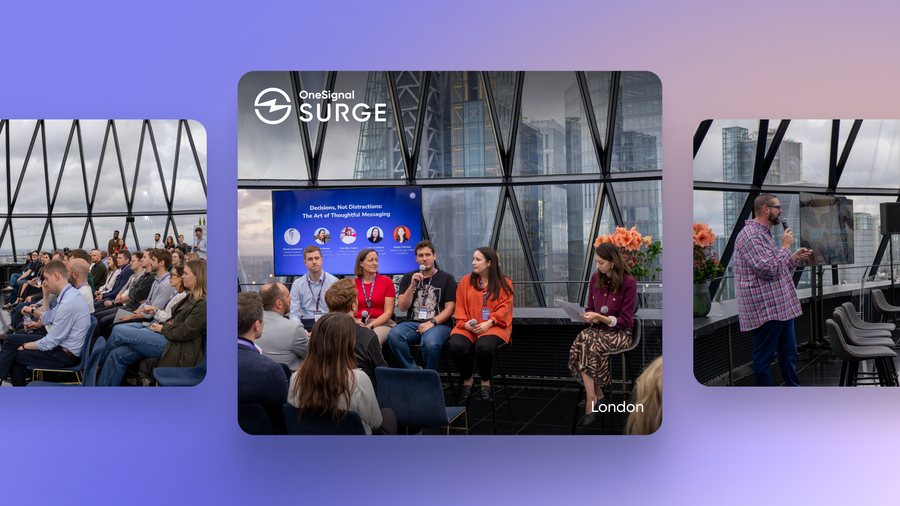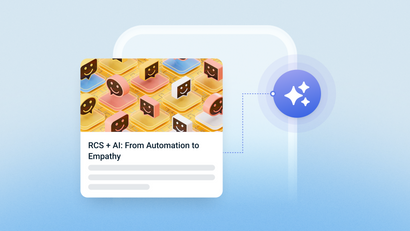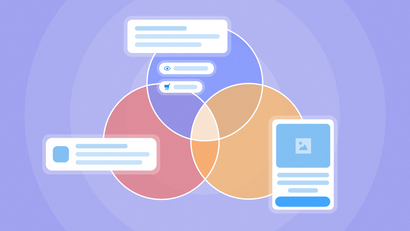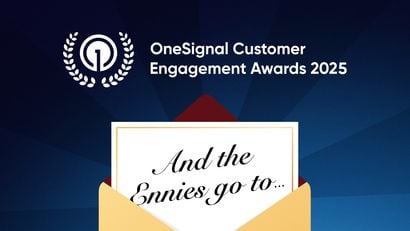Surge London brought together some of the most forward-thinking product, growth, and engagement leaders from across Europe’s mobile ecosystem. From AI’s impact on discovery to the realities of real-time engagement at scale, the room was packed with practitioners who think deeply about user behavior (and who understand that the customer relationship is being rewritten in real time.)
To everyone who joined us: thank you. The conversations, questions, and stories shared reinforced exactly why we go out of our way to create a space where builders can learn from each other.
If you missed it (or simply want the highlights), here are the 10 biggest takeaways that every mobile marketer, lifecycle owner, and growth PM should walk away with.
The lion’s share of these insights came directly from our stellar panel of engagement experts. Thank you for taking the time to sit down with us and share your wisdom with us!
- Yarin Ben Yaakov, Product Manager of Match Masters at Candivore
- Rachel Beaton, Commercial Director at Octopus Electroverse
- Charlie Carmichael, Head of Audience at News Broadcasting
- Laura Crimmons, Head of Growth Management at Ringier
1. AI is changing discovery. So, direct customer relationships matter more than ever.
First up, a valuable reminder from OneSignal’s own CMO, Jason Seeba, that AI is compressing the entire discovery journey into a single answer, and why preserving direct customer relationships is more important than ever.
Search used to help people find things. Increasingly, AI is helping them get things.
That shift will fundamentally reshape how users encounter brands. In a world where LLMs answer questions instead of linking outward, where zero-click environments are rising, and where content is being generated at scale, mobile brands can’t rely on SEO or virality alone to build demand.
The real moat is your owned audience.
Email lists. Mobile push subscribers. App users. Community members.
And most importantly: the strength of your ongoing relationship with them.
The window for brands to secure that relationship is narrowing. The winners will be the apps that build durable, habitual engagement, not the ones hoping to be “discovered” by the new algorithmic gatekeepers.
2. The era of one-off, transactional messaging is over. Users expect ongoing experiences.
Growth teams once chased quick hits: one-time incentives, splashy promos, campaigns engineered for short-term spikes.
But today’s best-performing apps focus on steady, relationship-centric communication:
- Habit loops
- Recurring rituals (think: Duolingo streaks or Spotify Wrapped)
- Useful touchpoints that make the app feel like a companion
Ask yourself: Are you designing moments that users forget… or rituals they look forward to?
→ Map your last 5 campaigns and label them “transactional” or “relationship-building.” If the balance skews toward quick wins, it’s time to rebalance.
3. What makes “real-time” work? HINT: it’s not speed.
Every team at Surge London agreed: real-time engagement only works when it reflects the user’s moment, not your internal clock.
The teams getting real-time right focus on:
- User-triggered events (e.g., completing a daily challenge)
- Live moments with true urgency (sports, broadcasts, time-sensitive rewards)
- User’s timezone to avoid the cardinal sin: waking someone up in the middle of the night
- Intent signals that confirm a user is ready to engage, purchase, or act
Relevance beats immediacy every time. A push sent instantly but out of context feels spammy. When your timing matches user intent, engagement becomes a bit more like a reflex.
4. Notification fatigue might not be as much about frequency as you thought…
One misconception: more notifications = more fatigue.
But real fatigue comes from:
- Filler content
- Off-topic stories
- Generic blasts
- Messages sent because “we need to send something today”
Yet in some verticals—sports, breaking news, gaming—users expect a lot of messages, as long as they’re the exact messages they care about.
The takeaway:
Frequency capping is less important than editorial nuance and audience tuning.
Look at your own audience. Do you know which users want everything and which users only want the essentials?
5. Letting users control their experience builds trust (and reduces churn)
One of the strongest themes we heard across the board? Empower your users.
Let them:
- Pick content categories
- Choose game modes or features they care about
- Control cadence
- Opt into (or out of) specific real-time updates
Users who feel ownership over their push experience are dramatically more likely to stay opted-in, and to come back frequently.
This also creates a feedback loop: user-declared preferences become first-party data you can activate across your messaging, personalization, and product surfaces!
6. Great personalization combines explicit signals + behavioral signals
Every panelist emphasized that personalization is not one dataset, it’s two:
1. What users say they want
Chosen interests, category subscriptions, declared preferences.
2. What users show you they want through behavior
Clicks, time spent, scroll depth, return frequency, content consumption patterns, preferred modes/features.
The ✨magic✨ is in combining both.
This dual approach lets apps:
- Tailor real-time updates
- Adjust message frequency by engagement tier
- Use AI to fill gaps in content supply
- Identify “hyper-engaged” users vs. casual browsers
- Predict what users want next
When apps listen, respond, and predict well, their experiences feel naturally personalized.
7. Avoid the “Creepy Zone” with privacy-conscious messaging
The line between helpful and intrusive is thin, and users feel it instantly.
Privacy-conscious messaging strategies included:
- Using a consistent, human tone of voice
- Applying subtle suggestions instead of “We saw you clicked X”
- Meeting EU expectations (especially in Germany and Switzerland) around consent
- Providing clear controls in-app
- Prioritizing first-party data over opaque behavioral models
The goal: be a friend, not a stalker!
8. Segmentation should be dynamic, not static
Static segmentation (e.g., “all boxing fans”) doesn’t reflect real user behavior.
Modern segmentation adapts continuously as interest rises and falls. For example:
- Casual boxing fans who get reactivated, only during a major fight
- New players who show interest in a specific mode or reward
- Readers who go deep on a particular topic for a few days
- Users whose engagement spikes around events, releases, or holidays
Dynamic segmentation means:
- Pull users into segments as their intent strengthens
- Serve the right content while interest is high
- Release them out of segments as interest fades
Doing this well creates relevant, time-bound journeys that feel tailored and alive.
9. Retention starts on Day One, not when a user is “at risk”
By the time a user has been dormant for a few weeks, it’s too late.
Effective retention strategies start:
- In the welcome flow
- In the first session
- In the first 24 hours
- With clear onboarding guidance
- With incentives and nudges that build early momentum
For users who do drift away, top strategies included:
- Using in-app messages to diagnose intent
- Soft-touch return flows (“thanks for coming back”)
- Reward mechanisms that gently re-integrate them
- Grace periods before pushing heavy prompts
- Avoiding sending messages about content they’ve missed—focus on what’s happening now
Start viewing retention as more than just a last step in your lifecycle strategy. Retention is a philosophy baked into every moment of the user journey.
10. AI should augment your work, not replace your expertise
Every brand in the room is experimenting with AI, but all echoed the same guiding principle:
AI is there to help lighten the load, not change the relationship you have with your users.
Best uses of AI today:
- Translation at scale
- Accelerating content workflows
- Auto-summarizing long-form media
- Generating variants for testing
- Synthetic panel research using real user data patterns
- Filling content gaps where supply is thin
But the red line was clear:
Apps should remain the trusted arbiter of truth, taste, and experience. Users come for your expertise, not “AI slop.”
The brands that win will blend AI’s efficiency with a strong editorial voice and curated ecosystem.
🌟 Bonus insight: Community is the next big advantage in an AI-driven world
As AI makes answers more instantaneous and commoditized, the irreplaceable differentiator becomes community and participation.
People want to:
- Vote
- Comment
- Debate (in a healthy way)
- Feel part of the narrative
- Shape the experience with their input
And some of the most compelling examples from Surge London came from teams intentionally designing beyond the two-dimensional user experience.
Charlie Carmichael, Head of Audience at News Broadcasting, shared a powerful illustration:
🎬 When their on-air pundits debate who’s likely to win the Premier League title, they don’t want listeners to be passive. Instead, they push a live poll in the app asking fans for their predictions.
🎙️ Those results are fed back to the pundits an hour later, sparking a follow-up discussion influenced directly by audience input.
🔄 The segment gets clipped for YouTube, then delivered back to the very fans who participated in the poll—closing the loop and making them feel like co-creators in the experience.
This turns users into actual contributors and transforms content from something static into something cyclical and participatory. Most importantly, it gives fans a sense of ownership, something AI can’t replicate.
Thanks for joining us… See you at the next Surge!
Surge London reminded us that the mobile engagement world is changing fast, but the fundamentals aren’t going anywhere. Users still want value. They still want relevance. They still want connection. And they reward brands who put in the work to understand them.
If you joined us in London, thank you for helping make it such a thoughtful, energizing day. If not, stay tuned for more. We’re always on the hunt for the most creative, effective, and ethical ways to stay close to users as technology shifts. In the meantime, explore OneSignal and start building the kind of experiences users return to again and again.
Get Started for Free



